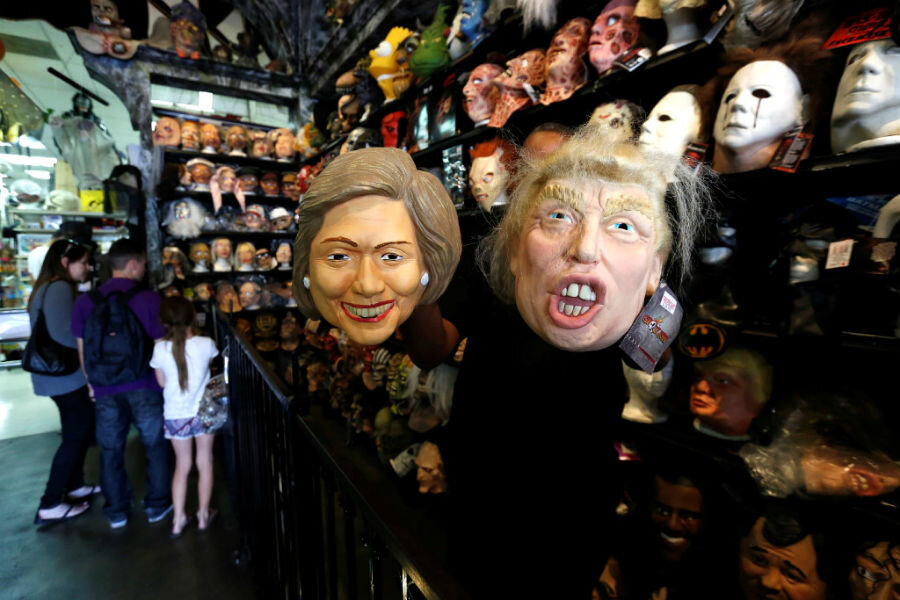Can a Halloween costume be hate speech?
Loading...
A Halloween costume involving President Obama, Hillary Clinton, Donald Trump, and a noose worn by two attendees at a University of Wisconsin football game has reignited the debate on the role universities play in protecting free speech and curbing hateful words.
Halloween costumes have a tendency to usher in instances of cultural appropriation and stereotypes some find offensive, especially on college campuses where student bodies are becoming increasingly diverse. Some schools have recently encouraged students to make costume choices that don’t emulate specific racial groups or other minorities. Other schools have instituted outright bans on certain costume choices they say create hostility or danger on campus. The recent clashes, paired with a growing tendency to cater to “politically correct” guidelines, have put universities in an odd position that sometimes involves policing attire and activities on and around campus — moves that could violate the First Amendment.
“In any event, it’s constitutionally protected speech,” Eugene Volokh, a law professor at the University of California, Los Angeles, tells The Christian Science Monitor. “Many of those policies are clear First Amendment violations. Generally speaking, you cannot say, this is our property so you can’t say this or that.”
On Saturday, two attendees at a University of Wisconsin football game arrived with masks of Mr. Trump, Mrs. Clinton, and Mr. Obama. The person wearing the Trump mask held the end of a noose that was wrapped around the neck of the person who would alternate between wearing a Clinton or Obama mask and dressed in prison garb.
Officials at the stadium requested that the attendees remove the noose from the costume, and the pair complied.
As word and images of the costume spread online, students and others around the country decried the costume, saying it was an incident of hate speech and shouldn’t receive protection from the university.
“Some have asked why the individual was not ejected,” University of Wisconsin-Madison Chancellor Rebecca Blank said in a statement, noting that without the noose present, the costumes fell within the stadium’s guidelines for attire. “As offensive as this costume was, I believe our university must resist the desire to outlaw forms of speech and political dissent with which we disagree. We strive to build a campus community in which ideas and expression are exchanged freely, but also constructively, respectfully and in a manner that advances educational opportunities for our students.”
But hate speech doesn’t necessarily fall outside of the realm of First Amendment protections. Threats and fighting words, two defined legal categories that don’t receive protection, sometimes overlap with speech that is hateful towards a specific group. But hate speech itself doesn’t have a concrete federal legal definition. Without any indication that it could result in actual harm to others, damning remarks that reflect racism, sexism, or other hateful ideologies tend to receive constitutional protection.
When it comes to costuming, a form of speech protected by a 1970 Supreme Court ruling Schacht vs. United States, the same rationale applies.
“It is difficult to imagine a costume that on its own would be unprotected,” Samantha Harris, the director of policy research at the Foundation for Individual Rights in Education, a Philadelphia-based group that advocates for free speech on college campuses, tells the Monitor. “Harassment and threats are something very contextual.”
For example, she says, dressing up in a Ku Klux Klan robe is protected, but arriving at the dorm room of black students uninvited may be considered threatening.
“It would have to be considered in context,” Ms. Harris says. “A lot of things can be harassment depending on when they were said.”
Last year, a case at Yale University made national headlines when the university sent out an email requesting that students make culturally sensitive choices when selecting their costumes. In response, faculty member Erika Christaki penned an email encouraging students to wear whatever costumes they wanted to, and start a dialogue with one another when something appeared offensive.
“I wonder, and I am not trying to be provocative: Is there no room anymore for a child or young person to be a little bit obnoxious … a little bit inappropriate or provocative or, yes, offensive?” she wrote. “American universities were once a safe space not only for maturation but also for a certain regressive, or even transgressive, experience; increasingly, it seems, they have become places of censure and prohibition.”
That call was met by a strong backlash from students who called for the resignation of Ms. Christaki. While opinions and ideologies steeped in controversy or even racism may find protections within the Constitution, experts say that responding to them through dialogue can become a better way to curb hateful ideas than any legal ban, as stigmatizing hateful comments can serve as a powerful tool.
“The best response to speech you disagree with or find offensive is more speech,” Harris says. “The right to free speech protects one from the legal consequences, but it doesn’t protect them from social consequences.”
Still, several universities across the country have crafted bans on “offensive” costumes, with a county in Mississippi going so far as to ban creepy clown costumes entirely until November, AL.com reported. While some neutral bans, like those against nudity or realistic-looking weapons, may pass a First Amendment test, institutions and officials seeking to bar costumes to make sure no one is made uncomfortable don’t have a strong case for censorship, say legal scholars.
“You can imagine the university saying, look this isn’t speech we can throw someone in jail for, but in this stadium we’re going to impose some kind of reasonable viewpoint neutral restrictions,” Mr. Volokh says. “Universities can be uncomfortable all they want, but the First Amendment doesn’t guarantee comfort to university administrators."'








